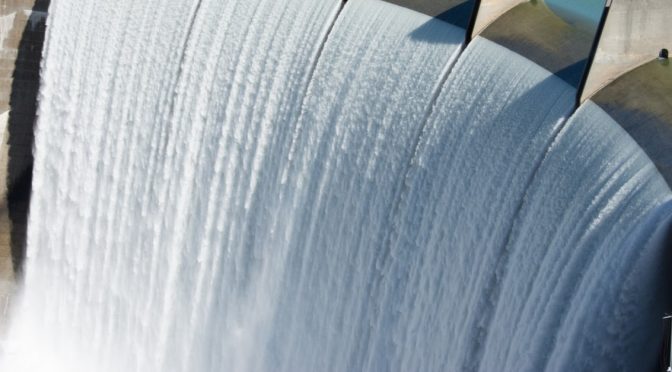This summer, Americans can clearly see and smell the evidence of climate change. Along the Eastern Seaboard, people have inhaled smoke from the nearly 900 wildfires ravaging Western Canada. This July was Earth’s hottest month ever recorded
. Dangerous heat waves and heat domes have strangled cities for weeks at a time.
But within all this climate chaos, there’s still plenty of progress. This year, the world is set to increase its renewable energy capacity by 107 gigawatts to reach a total capacity of 440 gigawatts—that’s more than the entire installed power capacity of Germany and Spain combined, according to the International Energy Agency
. And while much of that growth will come from solar power and wind energy, these variable renewables need a steady partner to make sure the power grid is not only clean but also reliable and resilient.
Hydropower is one of those unwavering partners.
, the U.S. Department of Energy’s Water Power Technologies Office (WPTO) is sharing just a few examples to illustrate why hydropower is key to a dependable clean energy future.
Video Url
https://youtube.com/watch?v=HxUCGg3R0X0%3Fautoplay%3D0%26start%3D0%26rel%3D0%26enablejsapi%3D1%26origin%3Dhttps%3A%252F%252Fwww.energy.gov
Hydropower has been and will continue to be key to a clean energy grid. WPTO supports research and development focused on modernizing existing infrastructure and developing new technologies.
Video by U.S. Department of Energy
Key to Resilience in Extreme Weather
As the climate shifts, summers like this one will likely become more common. Extreme weather is stressful for citizens and the power grid. In 2021, the average American household spent a total of about seven hours without power, according to the U.S. Energy Information Administration
. About five of those dark hours were the result of major events, like snowstorms, hurricanes, or wildfires.
If the power goes out, hydropower facilities can help the grid recover. Because these facilities can respond quickly to grid changes, they’re often crucial for the power system to react to extreme events, according to a study from researchers at several national laboratories
. For example, hydropower plants can help jump-start the grid after a blackout through a process called “black start.” A black start restarts operation of a power plant from a completely unenergized state so it can then power up other generating plants, thus restoring power to the grid.
Meanwhile, even if droughts strain water supplies, hydropower facilities can still provide reliable power. An analysis from Pacific Northwest National Laboratory found that although drought raises concerns for hydroelectric generation, the overall hydropower fleet sustained 80% of its average generation between 2001 and 2021. Hydropower could still be relied upon to supply flexible power during periods of high energy demand, even during the most severe droughts of the past two decades.
Key to Energy Independence and Local Jobs
Hydropower’s flexible energy can help communities unlock their own clean and dependable power systems. For example, residents of Dillingham, Alaska, who currently depend on expensive shipments of diesel fuel, are evaluating how hydropower could help them achieve both energy resilience and independence.

Students participating in the 2023 Hydropower Collegiate Competition, along with the Marine Energy Collegiate Competition, gathered in Washington, D.C., for the final competition events.
Image from Taylor Mankle, National Renewable Energy Laboratory
As hydropower grows to meet the country’s energy demand, its workforce will need to keep pace, too. Today’s hydropower workforce faces a wave of retirements, and a new, diverse workforce is critical to the industry’s ability to sustain operations and grow. To inspire students to join this powerful industry, WPTO launched the Hydropower Collegiate Competition
. The first winners were announced in May 2023 along with the teams selected to participate in the 2024 competition!
Key to Sustaining and Growing Hydropower
Hydropower’s role on the electricity grid may be big, but future facilities will be far less imposing than familiar ones like the Hoover Dam. Instead, new hydropower development can capitalize on existing structures, such as human-made conduits (like pipelines and irrigation canals) and dams without power-generating infrastructure, to deliver more hydropower with minimal to no environmental impacts. And, in a 2022 study from Argonne National Laboratory, researchers found many promising technologies that could help reduce the cost and timeline to build new pumped storage hydropower, a valuable energy storage option for the clean energy future.
Along with expanding hydropower generation, it’s important to support the continued operation of existing facilities. Many of today’s plants are decades or even half a century old. With modern upgrades or refurbishments, these facilities will continue to play an important role on the grid.
The U.S. Department of Energy’s Hydroelectric Incentives, administered through the Grid Deployment Office, aim to add hydroelectric capacity to non-powered dams and incentivize hydropower investment in capital improvements related to efficiency, grid resilience, dam safety, and environmental conditions.
DOE is currently reviewing applications for the Fiscal Year 2023 solicitations for the $125 million Hydroelectric Production Incentive and the $75 million Hydroelectric Efficiency Improvement Incentives. Eligible hydropower facilities can still apply for another program, the $553.6 million Maintaining and Enhancing Hydroelectricity Incentives, through 5 p.m. ET on October 6, 2023 (as long as they submitted a letter of intent by June 22, 2023).
Hydropower is critical to the electricity grid—both today and tomorrow. And this renewable key doesn’t just open a single door—it’s a key to unlock cleaner communities, clean energy jobs, and the clean energy future the country needs.
Stay up to date with the latest hydropower funding opportunities, events, and news by subscribing to the monthly Hydro Headlines and bimonthly Water Wire newsletters.


